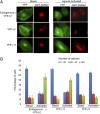Regulation of Golgi structure and secretion by receptor-induced G protein βγ complex translocation
- PMID: 20534534
- PMCID: PMC2895111
- DOI: 10.1073/pnas.1003042107
Regulation of Golgi structure and secretion by receptor-induced G protein βγ complex translocation
Abstract
We show that receptor induced G protein betagamma subunit translocation from the plasma membrane to the Golgi allows a receptor to initiate fragmentation and regulate secretion. A lung epithelial cell line, A549, was shown to contain an endogenous translocating G protein gamma subunit and exhibit receptor-induced Golgi fragmentation. Receptor-induced Golgi fragmentation was inhibited by a shRNA specific to the endogenous translocating gamma subunit. A kinase defective protein kinase D and a phospholipase C beta inhibitor blocked receptor-induced Golgi fragmentation, suggesting a role for this process in secretion. Consistent with betagamma translocation dependence, fragmentation induced by receptor activation was inhibited by a dominant negative nontranslocating gamma3. Insulin secretion was shown to be induced by muscarinic receptor activation in a pancreatic beta cell line, NIT-1. Induction of insulin secretion was also inhibited by the dominant negative gamma3 subunit consistent with the Golgi fragmentation induced by betagamma complex translocation playing a role in secretion.
Conflict of interest statement
The authors declare no conflict of interest.
Figures





Similar articles
-
Regulation of G-protein signaling by RKTG via sequestration of the G betagamma subunit to the Golgi apparatus.Mol Cell Biol. 2010 Jan;30(1):78-90. doi: 10.1128/MCB.01038-09. Mol Cell Biol. 2010. PMID: 19884349 Free PMC article.
-
Receptor-mediated reversible translocation of the G protein betagamma complex from the plasma membrane to the Golgi complex.J Biol Chem. 2004 Dec 3;279(49):51541-4. doi: 10.1074/jbc.M410639200. Epub 2004 Sep 23. J Biol Chem. 2004. PMID: 15448129
-
G protein betagamma complex translocation from plasma membrane to Golgi complex is influenced by receptor gamma subunit interaction.Cell Signal. 2006 Oct;18(10):1758-68. doi: 10.1016/j.cellsig.2006.01.016. Epub 2006 Mar 6. Cell Signal. 2006. PMID: 16517125 Free PMC article.
-
G-protein βγ subunits as multi-functional scaffolds and transducers in G-protein-coupled receptor signaling.Cell Mol Life Sci. 2019 Nov;76(22):4447-4459. doi: 10.1007/s00018-019-03275-2. Epub 2019 Aug 21. Cell Mol Life Sci. 2019. PMID: 31435698 Free PMC article. Review.
-
G protein gamma subunit, a hidden master regulator of GPCR signaling.J Biol Chem. 2022 Dec;298(12):102618. doi: 10.1016/j.jbc.2022.102618. Epub 2022 Oct 19. J Biol Chem. 2022. PMID: 36272647 Free PMC article. Review.
Cited by
-
A short C-terminal peptide in Gγ regulates Gβγ signaling efficacy.Mol Biol Cell. 2021 Aug 1;32(16):1446-1458. doi: 10.1091/mbc.E20-11-0750. Epub 2021 Jun 9. Mol Biol Cell. 2021. PMID: 34106735 Free PMC article.
-
Gβ1γ2 activates phospholipase A2-dependent Golgi membrane tubule formation.Front Cell Dev Biol. 2014 Feb 28;2(4):0004. doi: 10.3389/fcell.2014.00004. Front Cell Dev Biol. 2014. PMID: 25019068 Free PMC article.
-
PAQR3 regulates Golgi vesicle fission and transport via the Gβγ-PKD signaling pathway.Cell Signal. 2015 Dec;27(12):2444-51. doi: 10.1016/j.cellsig.2015.08.017. Epub 2015 Aug 29. Cell Signal. 2015. PMID: 26327583 Free PMC article.
-
Inducible Inhibition of Gβγ Reveals Localization-dependent Functions at the Plasma Membrane and Golgi.J Biol Chem. 2017 Feb 3;292(5):1773-1784. doi: 10.1074/jbc.M116.750430. Epub 2016 Dec 19. J Biol Chem. 2017. PMID: 27994056 Free PMC article.
-
Alteration of Golgi structure in senescent cells and its regulation by a G protein γ subunit.Cell Signal. 2011 May;23(5):785-93. doi: 10.1016/j.cellsig.2011.01.001. Epub 2011 Jan 14. Cell Signal. 2011. PMID: 21238584 Free PMC article.
References
-
- Akgoz M, Kalyanaraman V, Gautam N. Receptor-mediated reversible translocation of the G protein betagamma complex from the plasma membrane to the Golgi complex. J Biol Chem. 2004;279:51541–51544. - PubMed
-
- Wilson BS, Komuro M, Farquhar MG. Cellular variations in heterotrimeric G protein localization and expression in rat pituitary. Endocrinology. 1994;134:233–244. - PubMed
-
- Gleeson PA, Lock JG, Luke MR, Stow JL. Domains of the TGN: Coats, tethers and G proteins. Traffic. 2004;5:315–326. - PubMed
Publication types
MeSH terms
Substances
Grants and funding
LinkOut - more resources
Full Text Sources
Molecular Biology Databases
Miscellaneous

